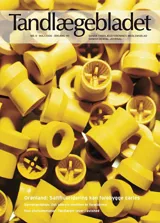Cervikale eksterne rodresorptioner. En oversigt
Resorption af tænder kan finde sted i såvel fysiologisk som i patologisk sammenhæng. De patologiske resorptioner kan udgå eksternt eller internt fra, og de eksterne resorptioner er typisk lokaliseret til enten den apikale eller den cervikale region. Der findes en lang række kendte årsager til patologisk betingede eksterne resorptioner, men mange tilfælde forekommer med en betydelig uforudsigelighed, og visse anses for idiopatiske. De kan derfor vanskeligt forebygges, og alle mere fremskredne former for resorptioner rummer behandlingsmæssige problemer. I mange tilfælde mistes de afficerede tænder, og det er ofte uforståeligt for patienterne at tandlægen hverken kan give en tilfredsstillende forklaring på forløbet eller tilbyde en effektiv behandling. I nærværende artikel gennemgås den særlige gruppe af de patologiske eksterne rodresorptioner som er karakteriseret ved at være lokaliseret til tændernes cervikale region.
Cervical external root resorptions: The article is a survey of pathologic external resorptions with a cervical localisation (CERR (cervical external root resorptions)). They are often unpredictable or idiopathic, and treament is difficult. Most often solitary teeth are affected, but multiple and general occurrences exist. Generally the patients do not feel any pain even if the pulp is affected, and the defects are often diagnosed by routine examination. The cementoid tissue covering the root surface provides a protection, and a destruction of this tissue seems to presuppose the initiation of a resorption. Known documented causes are: impactions, orthodontic treatments, bleaching, surgico-orthodontic treatments, and ionising radiation. Systemic explanations are denied by most authors. Among speculative causes are: endodontic treatments, traumata, chemical and biological influences. Etiologic factors of CERR are difficult to solve. Why do known causes only elicit defects in certain patients? And why do multiple resorptions affect certain groups of teeth? Treatment of CERR represents a challenge to the practitioner. Sometimes pulp treatment is necessary, access to crestal and infracrestal locations is difficult, and the resorbed tooth is weakened.


